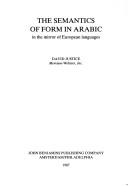| Listing 1 - 2 of 2 |
Sort by
|
Multi
ISBN: 9780748645282 9780748645275 0748645276 0748645284 0748645292 Year: 2014 Publisher: Edinburgh: Edinburgh University Press in association with The Aga Khan University,
Abstract | Keywords | Export | Availability | Bookmark
 Loading...
Loading...Choose an application
- Reference Manager
- EndNote
- RefWorks (Direct export to RefWorks)
This is an introductory guide for students of Arabic language, Arabic historical linguistics and Arabic socio-linguistics. New for this edition: a new chapter on the structure of Arabic; a new chapter on Pidgin and Creole varieties; and, data has been updated throughout in light of recent research. Concentrating on the difference between the two types of Arabic - the classical standard language and the dialects - Kees Versteegh charts the history and development of the Arabic language from its earliest beginnings to modern times. The reader is given a solid grounding in the structure of the language, its historical context and its use in various literary and non-literary genres, as well as an understanding of the role of Arabic as a cultural, religious and political world language. It covers all aspects of the history of Arabic, the Arabic linguistic tradition, Arabic dialects and Arabic as a world language. It makes links between linguistic history and cultural history. It emphasises the role of contacts between Arabic and other languages.
Arabic languages --- Arabic language --- History --- Arabic language -- Discourse analysis. --- Arabic language -- Rhetoric. --- Arabic language -- Usage. --- Arabic language -- Variation. --- History.

ISBN: 9027230161 9027230218 128323405X 9786613234056 9027282102 9789027230164 9789027282101 9789027230218 Year: 1987 Volume: 15 Publisher: Amsterdam: Benjamins,
Abstract | Keywords | Export | Availability | Bookmark
 Loading...
Loading...Choose an application
- Reference Manager
- EndNote
- RefWorks (Direct export to RefWorks)
Justice's first aim in this volume is to demystify the Arabic language, which is widely perceived as difficult to learn, and has been characterised as ambiguous and confusingly polysemous. The central concern of this three-dimensional portrait of Classical Arabic is a version of the Sapir-Whorf hypothesis that language is a determinant of other aspects of culture. But rather than focusing on the possible influences of language on thought, Justice is intersted in connections between language and language use or langue and parole. Among the topics treated are: the difficulty of Ara
Arabic language --- Semantics --- Rhetoric --- Lexicology. Semantics --- Arabic languages --- Grammar --- Redekunst (Arabische). --- Arabe [Langue]. Sémantique. --- Rhétorique arabe. --- Arabisch. Semantiek. --- Arabic language - Semantics --- Arabic language - Rhetoric --- Semantics. --- Rhetoric.
| Listing 1 - 2 of 2 |
Sort by
|

 Search
Search Feedback
Feedback About UniCat
About UniCat  Help
Help News
News